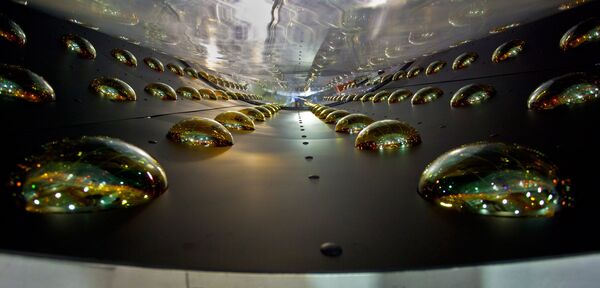European scientists may have inadvertently disproven Einstein's theory of relativity. Swiss and Italian physicists have recorded neutrinos traveling faster than the speed of light. The physicists are not sure about what they have observed: could it be a flaw in the experiment or the end of the Einstein's all-powerful theory?
Superluminal express across the Alps
This sensational finding did not appear over night. It is the result of over three years of work.
The famous CERN, the Geneva-based European Organization for Nuclear Research, directed its synchrotron southward, sending a flow of neutrinos to the other side of the Alps.
The Earth is round, so the neutrino flow moved directly through the rocks where it was received by a detector at Gran Sasso (OPERA) in Abruzzo in central Italy. The distance from point to point was about 732 km.
Antonio Eriditato, an official spokesman for OPERA, explained: "We measure the distance and we measure the time, and we take the ratio to get the velocity, just as you learned to do in high school." During three years the detectors at Gran Sasso captured about 16,000 neutrinos released by the CERN. As a result, the experiment was repeated 16,000 times.
But for all its apparent simplicity, the experiment has yielded a stunning result. On the average, neutrinos travelled the distance between the source and the detector 60 nanoseconds faster than light would in vacuum. According to the laws of modern physics, this is impossible.
Phantom particles
Who has disturbed the peace in physics?
American scientists first detected neutrinos in 1956, although the brilliant physicist Wolfgang Pauli predicted the existence of a "light neutral particle" in 1930.
It would not be entirely correct to use the word "predicted." He resorted to the neutrino hypothesis in order to save theoretical physics from one more disaster, as he phrased it. Scientists' understanding of the structure of the atomic nucleus at the time suggested conclusions that upset the immutable laws of conservation of energy.
Pauli's hypothesis settled the apparent contradiction. Enrico Fermi, Pauli's colleague from Italy, called the particle a "neutrino" in conversation and the name stuck. However, scientists detected these particles only a quarter century later.
Neutrinos turned out to be very volatile. They essentially do not interact with matter - space neutrinos pass straight through the Earth and continue their way. They are recorded only by indirect traces and essentially one at a time.
This explains the need for underground experiments. Scientists bury detectors deep beneath rock in order to cut off all unwanted radiation. But neutrinos pass through the rock with ease.
Swiss and Italian scientists have done it again. Only this time, rather than saving the accepted model of the time, they may have stumbled upon a discovery that could upend modern physics.
Paradigm shift
Strictly speaking, if the surprising finding at CERN is not explained away, physicists will have to adapt the entire understanding of the Universe. Needless to say, Einstein's theory of relativity will not be discarded - just as Isaac Newton's classical mechanics has been preserved - but supplemented to explain how something can travel faster than the speed of light. Now scientists will have to add to Einstein's theories. In this sense, physical theories are like a nesting doll.
For the time being, the authors of the experiment do not dare unequivocally interpret its results. This is too bold a step. They have posted the results on the Internet but have not yet published their findings officially, instead waiting to hear what their colleagues have to say.
Was it all wrong?
Skeptics are making their voices hear, and they sound convincing. Japanese colleagues of the physicists from CERN believe that this boils down to an undetected error. Simply put, they think that one and the same distortion affected each of the 16,000 tests. Chang Kee Jung, a neutrino physicist at Stony Brook University in New York, says he'd wager that the experiment was flawed. "I wouldn't bet my wife and kids because they'd get mad," he says. "But I'd bet my house."
The scientists who performed the experiments have searched for errors, too. Antonio Ereditato said: "Months of research and verifications have not identified an instrumental effect that could explain the result of our measurements. That's why we have published the results and are continuing our work. We hope that independent measurements by other groups will help us fully understand the nature of this observation."
Others note that at this velocity, 60 nanoseconds mean no more than 17-18 meters and that there could be many sources of such an error. "They have forgotten about some cable," some are joking on the Internet.
Alan Kostelecky, a participant in the experiment, said: "I suspect that the bulk of the scientific community will not take this as a definitive result unless it can be reproduced by at least one and preferably several experiments." He added that this may be for the better.
Regardless, scientists are facing a real challenge. They should either find the error in the experiment or repeat it, and if it yields the same result, physicists will have to create a new physics.
The former is simpler and more likely but the latter would certainly be more interesting.
The views expressed in this article are the author's and may not necessarily represent those of RIA Novosti.



